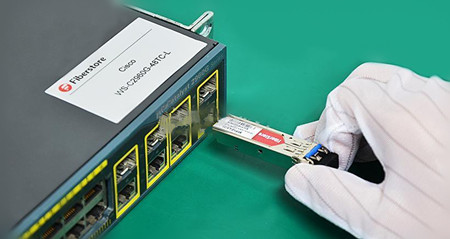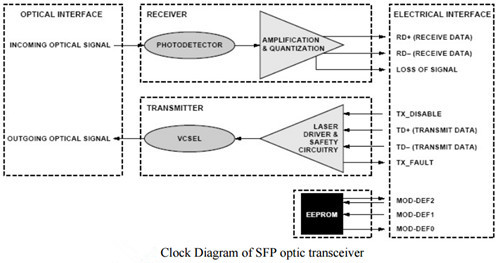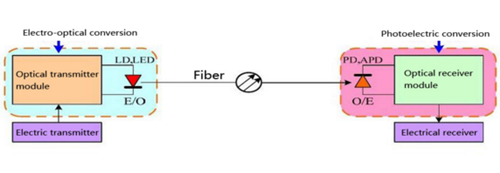Small form factor pluggable (SFP) optical transceiver nowadays is commonly utilized in the telecom field for Ultra-high-speed transmission applications as well as for low-cost applications. Characterized by small form-factor, pluggable and self-diagnose, Gigabit SFP transceiver becomes the most popular application for fiber optic systems including asynchronous transfer mode (ATM), FDDI, fiber channel, fast Ethernet and gigabit Ethernet, and synchronous optical network (SONET)/synchronous digital hierarchy (SDH). SFP transceiver has dominated the market over a long time. Recently many vendors provide SFP transceiver with different specifications, but SFPs from Cisco are the standardized optical transceivers which are greatly favored by users. People may know what SFP transceiver is, but do they really know about SFP transceiver? The following article will offer a brief introduction to Cisco SFP first, then go further to the basics of the SFP transceiver.
Cisco SFP Module
Cisco industry-standard SFP modules can link your switches and routers to the network as shown in Figure 1. This hot-swappable device plugs into a Gigabit Ethernet port or slot. SFP transceiver are available in optical or copper models that can be used on a wide variety of Cisco products and intermixed in combinations of 1000BASE-T, 1000BASE-SX, 1000BASE-LX/LH, 1000BASE-EX, 1000BASE-ZX, or 1000BASE-BX10-D/U on a port-by-port basis.

Take 1000BASE-LX/LH SFP as an example, it is compatible with the IEEE 802.3z 1000BASE-LX standard for both multimode and single-mode fibers. The 1000BASE-LX/LH SFP like GLC-LX-SM-RGD, operates on standard single-mode fiber-optic link spans of up to 10 km and up to 550 m on any multimode fibers. When used over legacy multimode fiber type, the transmitter should be coupled through a mode conditioning patch cable. Some people may feel confused about the term—1000BASE-LX/LH. In fact, it is created by telecommunication vendor, but not a ratified standard. Cisco GLC-LH-SM is also a type of this SFP transceiver that is compatible with 1000BASE-LX standard. The only difference between GLC-LX-SM-RGD and GLC-LH-SM lies in the function of Digital Optical Monitoring support. Since we are familiar with the Cisco SFP transceiver, let’s move onto the structure of SFP.
The Structure of SFP
SFP transceiver is called Mini-GBIC for its smaller form-factor structure. A low-cost fiber optical transceiver circuit typically includes transmitter and receiver. The transmitter is composed of LD, Reference generator, laser bias circuit, PECL Input buffer, Laser modulation-circuit, Laser bias circuit, Automatic power control, and Failure detection. The receiver is made up of PD, Input biasing, Auto-zero circuit, power supply decoupling &optimizing sensitivity, lever detector and so on. A photodiode preamplifier, an active band-pass filter, and an instrumental amplifier is experimentally achieved. Using the proposed circuit for measurement and on-line automatic monitoring, the efficiency of fiber-optic characteristics monitoring can be enhanced and on-line noise interference can be suppressed. The transfer functions and frequency response of the optical receiver are derived.

Optic Transmitter and Receiver
As noted before, the most significant part of the optical transceiver is the receive and transmit. To have a better understanding of the SFP transceiver, we need to take a closer look at the these two parts. Light source is the heart of the transmitter. The major function of a light source is to convert an information signal from its electrical form into light. Today's fiber-optic communications systems use either light-emitting diodes (LEDs) or laser diodes (LDS) as the light source. Both are miniature semiconductor devices that effectively convert electrical signals into light. They need power-supply connections and modulation circuitry. All these components are usually fabricated in one integrated package. Transistor based driver circuit need for this type LEDs. With the fast development of the optical technology, there are other light sources available for SFP transceiver—fabry-perot (FP) lasers, distributed feedback (DFB) lasers and vertical cavity surface-emitting lasers (VCSELs).

The key component of an optical receiver is its photo detector. The major function of a photo detector is to convert an optical information signal back into an electrical signal (Photocurrent). The photo detector in today's fiber - optic communications systems is a semiconductor photodiode (PD). This miniature device is usually fabricated together with its electrical circuitry to from an integrated package that provides power-supply connections and signal amplification.
The Working Principle of SFP Transceiver
From the above diagram, we can see that a SFP transceiver contains both transmitter and receiver in a single module. But how does a SFP transceiver work? In fiber optic data links, the transmitter takes an electrical input and converts it to an optical signal, which is coupled with a connector and transmitted through a fiber optic cable. The light from the end of the cable is coupled to a receiver, where a detector converts the light back into an electrical signal. In short, as the core of the optical communication devices, optical transceiver module completes optical signal light-electricity/electricity-light conversion function.
Conclusion
After going through this passage, you may have a clearer mind about the SFP transceivers. High performance and low cost SFP optic transceiver is highly desirable for fiber optic communications, but we can’t ignore the fact that SFP can only support up to 4.25 Gbps. For higher data rate like 10GbE or 40GbE, there are other optical transceivers to support them. Fiberstore offers a variety of optical transceivers for you to choose from.
评论
发表评论